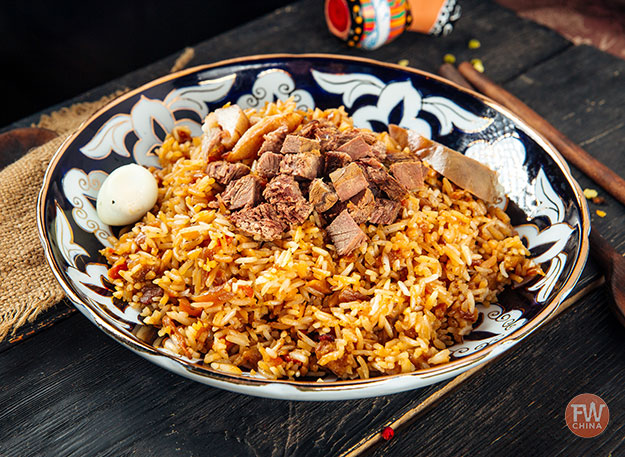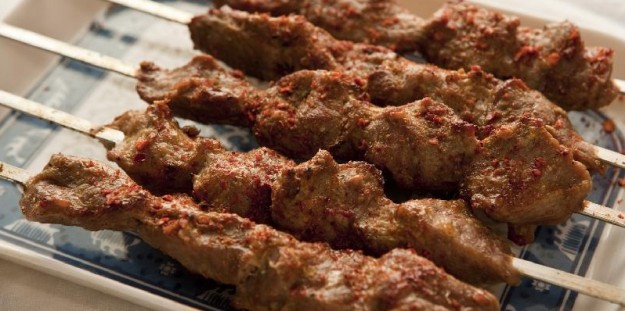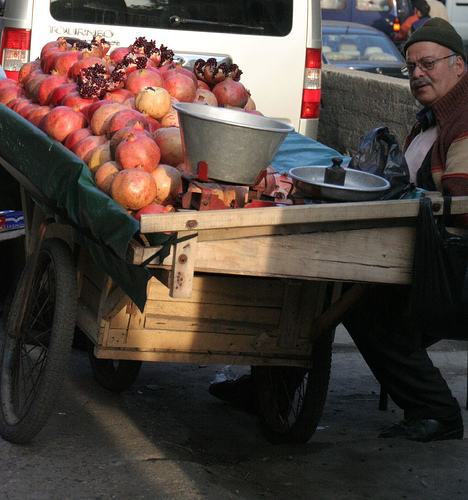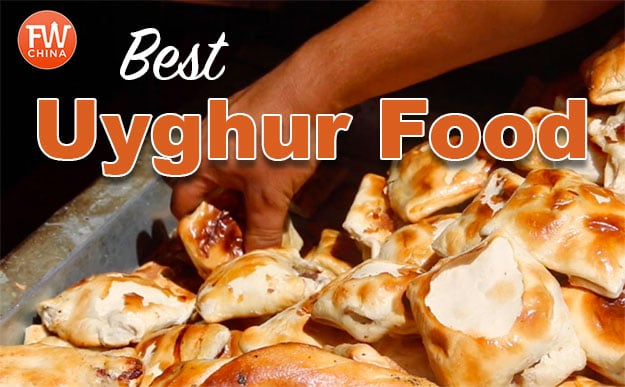Xinjiang Cuisine: 5 Must-Eat Foods (& How to Order Them)
What are the “must eat” foods while traveling in Xinjiang? There are plenty of things that I recommend that you try while you’re out here, but if I had to boil it down to my 5 favorite Xinjiang cuisine items, this would be it. Here are a list of the best foods and how you can order them!
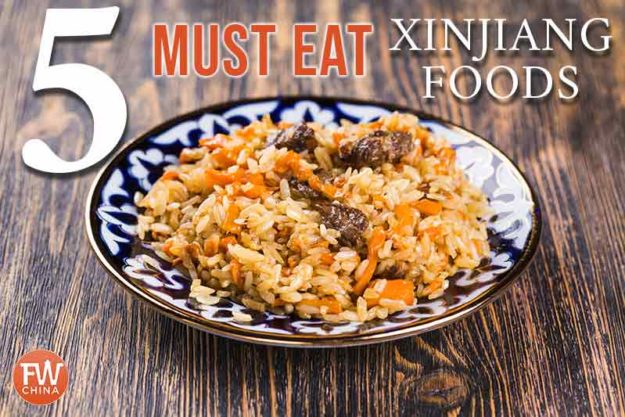
Of all the great Uyghur food, Hui food, Kazakh food and Russian food there is to eat out here in western China, it amazes me that I still hear of people traveling here without fully experiencing the wonderful Xinjiang cuisine.
I admit that it can be quite confusing, especially because there is no “one place” that serves all of the Xinjiang cuisine. I’m still in the process of discovering and trying all the various restaurants just in my neighborhood, much less what is available all across Urumqi.
But since most people don’t have the luxury of time that I do, I thought it might be helpful to compile a list of the top “must-eat” foods during your short stay here in Xinjiang. Perhaps you already know some of them but I would bet you don’t know them all.
And now you’ll know what’s worth your time to try…and how to order it.
Remember! If you’re traveling to Xinjiang in the near future, you’ll want to check out the FarWestChina Xinjiang Travel Guide, the most comprehensive, up-to-date guide on this region. It covers not just the food and the different minorities, but also all the holidays, cities, and places of interest! I’m so confident you’ll benefit from this guide that I’ll offer a personal refund for anybody that isn’t completely satisfied!
DaPanJi – Big Plate Chicken – 大盘鸡
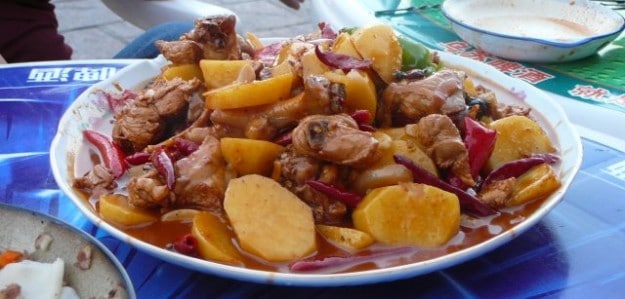
Big Plate Chicken (a.k.a. 大盘鸡 – dapanji) is one of the top dishes among travelers wishing to experience great Xinjiang cuisine.
Yes, you can order it at the Muslim Quarter in Xi’an or at a Xinjiang restaurant in Beijing, but trust me when I say that nothing compares to what is cooked up here in the province.
Xinjiang DaPanJi is often confused as a Uyghur dish, but it is in fact part of the Hui cuisine. It consists of a huge plate of potatoes, peppers, a whole chicken (including feet and sometimes the head!), and various spices.
This is a dish best served with a group, so find 4-5 local friends or fellow travelers, not only because it’s a lot of food but also because it can be quite expensive (100-150RMB per plate)
How to Order DaPanJi
Here are a few things to keep in mind as you order DaPanJi:
- DaPanJi can often be ordered as a half plate or a full plate. The average full plate feeds 3-4 people depending on hunger.
- Most DaPanJi is quite spicy, which I personally love. If you’re palette can’t stand fire, however, consider telling the waitress
- There are two types of DaPanJi – dapanji and dapantuji. That latter is a bit more expensive, but the chicken is tuji, which in western terms usually means a free-range, corn-fed chicken. Much healthier.
- Additions: To get the full experience, order some Uyghur naan to be served with the dish. Naan soaked in DaPanJi juice is incredible. Also, order a plate or two of noodles once you’re halfway through with your meal. Can’t let the good juices go to waste!
In Chinese
大盘鸡一盘 – dàpán jī yī pán
In Uyghur
Magha bir tahsa tuha kurdiki birig
Uyghur Polo – Pilaf – 抓饭
Coming in close second on the list of “must-eat” foods as part of the Xinjiang cuisine is Uyghur Polo. Some people spell it “pollo”, “polau”, or “pilaf” but it’s all the same thing.
Uyghur polo or “rice pilaf” is a mixture of carrots, peppers, rice and lamb meat cooked in an unreasonable amount of oil. It takes a while to prepare so in most restaurants it is only served for lunch (although I’m noticing more and more restaurants now serving it for dinner as well).
What I love about Uyghur Pollo is that it is fast to order and usually quite cheap (~20 RMB per plate).
How to Order Uyghur Pollo
It’s quite simple, actually – just walk into the restaurant, order, pay and eat. They will usually serve a plate of pollo with a side plate of carrots and vinegar.
I also highly recommend you try the Uyghur yogurt to wash the meal down. Personally, I add a spoonful of sugar to the yogurt (it can be quite tart!), but it’s a wonderful “dessert”.
In Mandarin:
抓饭一盘 – zhuā fàn yī pán
In Uyghur:
Magha bir tahsa pollo birig
Lamb Kebabs – KaoRou – 烤肉
Although not really a meal in itself (I guess it could be?), the famous Xinjiang lamb kebab is an essential part of the Xinjiang cuisine. It can be added to most any dish that you’re ordering.
Xinjiang lamb kebabs are nothing more than lamb meat on a stick, usually with alternating meat and fat pieces on the skewer. They sprinkle cumin and pepper on top as it is being cooked over a coal (more common) or wood (more authentic) fire.
When I first arrived in Xinjiang I could get kebabs for 1 kuai each, but times have changed over the past decade and they now range from 3-8 kuai each. Yikes! Luckily they’re also large so I’ll only order 2 or 3 in addition to my meal and be perfectly satisfied.
How to Order Kebabs
There aren’t too many options when it comes to kebabs, although there are a few restaurants that will serve different size kebabs (small pieces of meat vs large).
Order the kebabs along with your main dish and they’ll often come out first, an appetizers of sorts.
In Mandarin
{insert number} 个羊肉串 – gè yángròu chuàn
In Uyghur
Magha kawab {insert number} birig
Lagman – BanMian – 拌面/拉面
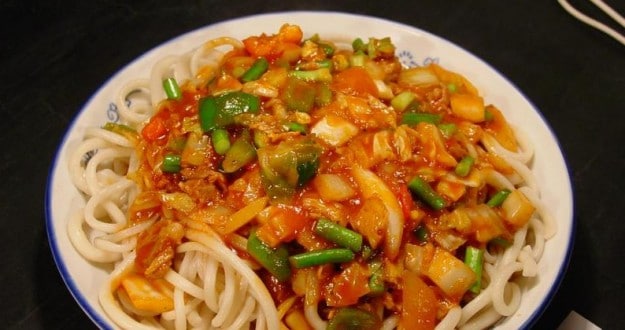
The term “BanMian” is actually quite a quite confusing Xinjiang cuisine name, as it seems to be used for any type of noodle dish out here. The good news is that no matter which type of BanMian you find yourself eating, you’ll probably love it.
Uyghur LaMian (a.k.a. Lagman)
The locals call the Uyghur version of BanMian “Laghman“, or “La mian”. Simply put, it’s a cooked dish of meat, vegetables and oil poured over a plate of noodles.
It happens often when I order this dish that they bring it out to me on two plates and either pour it together in front of me or allow me to take the honors. I haven’t quite figured out why that is.
Hui BanMian
Hui people are most famous for their noodles, which in my opinion make the Hui banmian better than the Uyghur lamian.
Hui noodles are stretched by hand in a process that takes an incredible amount of skill. If you have a chance to watch it happen, you’ll be amazed to witness the chef take a lump of dough, stretch it, slam it on the table, twist it and repeat the process a hundred times over until it becomes thin strands of noodle.
How to Order BanMian
The unfortunate part of ordering BanMian for most foreigners is the unbelievable number of choices. The menu board from one of my favorite local Hui restaurants is just one example – they have so many options that there’s actually one that translates into “Hodgepodge” (大杂烩). Ha!
My method is to just ask the waitress which is the most popular. It’s not a question they get regularly so they may look at you weird, but often they’re more than happy to offer a suggestion.
FYI – once you order your plate it’s not uncommon for a patron to ask for more noodles. Honestly, though, take it easy on the heavy noodles. Your stomach will thank you later.
In Mandarin
拉面一盘 – lāmiàn yī pán
In Uyghur
Man lahman ni yahxi kuriman
Uyghur Matang – 麻糖
Matang is one of the most popular Uyghur street foods that you can find pretty much all across China, not just in the Xinjiang province. Usually you’ll see a cart with various types of matang cut and available for purchase.
Uyghur matang is made using different types of nuts readily available in Xinjiang, kept together by honey. It’s a sweet snack that will get stuck in your teeth…but you’ll love it!
It’s really no use trying to list out the different types of matang that you could purchase since there are so many, so just choose your favorite nut (almond, walnut, cashew, etc) and get that bar.
How to Order Uyghur Matang
There’s not much to it! Just choose the amount you want – anything from a small sample slice to a large bar – and pay the vendor. Here’s how you would say what you want in both Uyghur and Mandarin:
In Mandarin
我想要麻糖 – wǒ xiǎngyào mátáng
In Uyghur
Mgha matag birig
Even More Xinjiang Cuisine
This is just the tip of the iceberg! If you’d like to see even more suggestions on what’s worth eating while traveling around Xinjiang, check out my video below that explains my top 10 Xinjiang food recommendations:
Don’t miss awesome, weekly videos…subscribe to FarWestChina on YouTube!
Other Xinjiang Food Resources:
- Looking for recipes? Check out these Great Xinjiang Uyghur Recipes
- A breakdown of my Top 10 Xinjiang Foods

